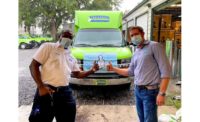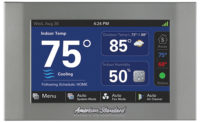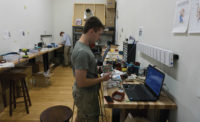James River Air Conditioning Inc. is involved in residential and commercial heating, air conditioning, plumbing, and electrical work in central Virginia. Joyce has always been passionate about the energy situation in America, and he set out to show potential customers and the community some practical solutions for conserving energy.
Project Leads to LEED
“Initially we were trying to create a spot where we could show our clients what we do with an ERV, a programmable thermostat, and a high-efficiency heat pump,” Joyce said. But he and his team didn’t stop there.
“Then we said let’s see how efficient we can make it, and let’s see if we can get the home LEED certified.”
Ultimately, the Solar Idea Home that resulted from these efforts received LEED Platinum certification from the U.S. Green Building Council (USGBC). Joyce is proud of the certification — and the fact that he accomplished it without the assistance of an architect or an engineering firm.
Intelligent Products Play A Role
The Solar Idea Home utilizes innovative products that are readily available and demonstrate progressive trends from within the HVAC industry.
A bank of Kyocera solar modules are mounted on a solar tracking device. The highly efficient multi-crystal photovoltaic modules are encapsulated between a tempered glass cover and an EVA pottant with a PVF back sheet all installed in an anodized aluminum frame. According to Joyce, the solar installation keeps the monthly electric bill down around $20. Plus, he claims that half of the bill is dedicated to fees, rider charges, and taxes.
To increase kW by 30 percent, James River Air Conditioning mounted the panels on a Wattsun tracking system, which is manufactured by Array Technologies. According to the company, an azimuth tracker gear drive rotates the solar panel array on a pole mount so the bottom edge of the array always remains parallel to the ground. The result is a low profile and exceptional stability in the wind. A dual-axis tracker enables automatic tracking of the sun’s elevation as well. The active trackers are guided by an optical, sun-sensing device that dramatically outperforms passive tracking systems. Solid state electronic design and positive drive mechanisms ensure consistent operation in extreme temperatures and windy conditions.
Joyce chose a Westinghouse iQ Drive heat pump to achieve high efficiencies in heating and cooling. The product uses inverter-rotary technology to exactly offset the cooling and heating demands on the home. This results in a SEER rating of up to 22 and an HSPF of up to 10. According to company literature, the unit modulates from 40 to 118 percent of capacity, making constant small adjustments.
“The controller determines how much capacity is needed,” explained Dave Koesterer, director of engineering performance systems for Westinghouse. “It tells the air handler how much air to deliver and the heat pump what capacity it needs to deliver, and that communication is closed loop and it is continuous.”
The iQ Drive communicating thermostat also provides maintenance reminders and troubleshooting diagnostics for the contractor. There are a number of different sensors in the system where performance data is stored and accessed. Technicians can quickly monitor operating parameters such as compressor discharge temperature, operating speed, the current draw of the outdoor unit, fan speed, target airflow, as well as information about the defrost cycle. If there is a system fault, it is recorded and logged in the thermostat control so that a service person can look at the history to determine when and how many times a fault has occurred.
Another intelligent feature of the Solar Idea House are the light switches and receptacles that utilize a system called Insteon. Using both the existing wires (power line) in the home and radio frequency communication, Insteon adds remote control and automation to lighting, which can be controlled remotely using a computer or smartphone.
Monitoring and Tracking Energy Use
Joyce is able to closely monitor energy consumption in the structure with two intelligent products: The Energy Detective (TED) and PlotWatt. TED, a home electricity monitor that is permanently installed in the breaker panel, provides real-time data in an easy-to-understand manner. TED’s Load Profile Wizard is a software-based program that learns how much electricity an appliance uses when it’s off or on. TED tracks up to five individual appliances and provides a daily total usage and associated costs.
PlotWatt works in conjunction with the TED monitoring system to monitor and analyze energy usage of appliances in the home. Located at https://plotwatt.com, it is a free cloud-based online service. The PlotWatt Energy Dashboard enables the user to remotely receive information on energy usage along with recommendations. The company claims beta users have cut their bills by as much as 50 percent.
“The whole deal with TED and PlotWatt is to get the homeowner to watch what is going on. You can’t fix what you can’t monitor,” Joyce said.
To achieve the LEED Platinum certification, James River incorporated several other products into the home, including a Honeywell whole-house energy recovery ventilator; an Atmos Air ionization air purifier; rainwater recovery for irrigation; grey water recovery for irrigation of trees; icyrene foam insulation in the crawl space, walls and attic; and Energy Star appliances.
Ongoing Investment
Joyce and several others at his company have invested a significant amount of time, effort, and money to make the Solar Idea House a reality. And they continue to invest by opening the house for tours for schools and colleges in the Richmond area.
“For us it’s been a great sales tool, marketing tool, and a learning tool,” Joyce said. “It creates a very good profile for us in the community and it lets me go out and talk about all the energy issues and have credibility.”
James River Air Conditioning has taken its practical approach to energy conservation to the next level by renovating another home in the Richmond area with Steve Lloyd, a general contractor. Many of the same products featured in the Solar Idea House are also utilized in the new home, which was placed on the market for sale in November.
Joyce called the Solar Idea House the ultimate marketing tool. But, he also cautioned his fellow contractors about investing in a demonstration home.
“Don’t get involved if you are looking for an immediate return; instead do it because you want to make a statement and be part of a movement,” said Joyce.
For more information, visit www.thesolarideahouse.com.
Publication date: 12/10/2012








